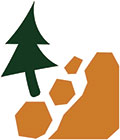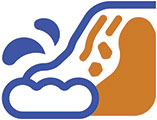Preparing for a Potential Landslide
 The following are things you can do to protect yourself, your family and your property from the effects of a landslide or debris flow:
The following are things you can do to protect yourself, your family and your property from the effects of a landslide or debris flow:
- Prepare for landslides by following proper land-use procedures – avoid building near steep slopes, close to mountain edges, near drainage ways or along natural erosion valleys.
- Become familiar with the land around you. Learn whether debris flows have occurred in your area by contacting local city or county officials. Slopes where debris flows have occurred in the past are likely to experience them in the future.
- Get a ground assessment of your property if possible.
- Consult a professional for advice on appropriate preventative measures for your home or business, such as flexible pipe fittings, which can better resist breakage.
- Protect your property by planting ground cover on slopes and building retaining walls.
- In mudflow areas, build channels or deflection walls to direct the flow around buildings. Be aware, however, if you build walls to divert debris flow and the flow lands on a neighbor’s property, you may be liable for damages.
- If you are at risk of property damage from a landslide, talk to your insurance agent. Debris flow may be covered by flood insurance policies from the National Flood Insurance Program (NFIP).
Recognize Landslide Warning Signs
- Changes can occur in landscape such as patterns of storm-water drainage on slopes (especially the places where runoff water converges) land movement, small slides, flows, or progressively leaning trees.
- Doors or windows stick or jam for the first time.
- New cracks appear in plaster, tile, brick, or foundations.
- Outside walls, walks, or stairs begin pulling away from the building.
- Slowly developing, widening cracks appear on the ground or on paved areas such as streets or driveways.
- Underground utility lines break.
- Bulging ground appears at the base of a slope.
- Water breaks through the ground’s surface in new locations.
- Fences, retaining walls, utility poles, and/or trees tilt or move.
- A faint rumbling sound that increases in volume is noticeable as the landslide nears.
- The ground slopes downward in one direction and may begin shifting in that direction under your feet.
- Unusual sounds, such as trees cracking or boulders knocking together, might indicate moving debris.
- Collapsed pavement, mud, fallen rocks, and other indications of possible debris flow can be seen when driving (embankments along roadsides are particularly susceptible to landslides).
During a Landslide
 During a severe storm, stay alert and awake. Make sure your communications devices are charged and ready if power goes out.
During a severe storm, stay alert and awake. Make sure your communications devices are charged and ready if power goes out.- Listen to local news stations or NOAA Radio for warnings of heavy rainfall.
- Listen for unusual sounds that might indicate moving debris, such as trees cracking or boulders knocking together.
- Move away from the path of a landslide or debris flow as quickly as possible. The danger from a mudflow increases near stream channels and with prolonged heavy rains. Mudflows can move faster than you can walk or run. Look upstream before crossing a bridge and do not cross the bridge if a mudflow is approaching.
- Avoid river valleys and low-lying areas.
- If you are near a stream or channel, be alert for any sudden increase or decrease in water flow and notice whether the water changes from clear to muddy. Such changes may mean there is debris flow activity upstream so be prepared to move quickly.
- Curl into a tight ball and protect your head if escape is not possible.
After a Landslide
- Go to a friend or family member’ s home or a designated public shelter if you have been told to evacuate or you feel it is unsafe to remain in your home.
- Stay away from the slide area. There may be danger of additional slides.
- Check SoCoEmergency.org for the latest emergency information.
- Watch for flooding, which may occur after a landslide or debris flow. Floods sometimes follow landslides and debris flows because they may both be started by the same event.
- If there are known injured or trapped persons near the slide, without entering the direct slide area, direct rescuers to their locations.
- Be aware of and report broken utility lines as well as damaged roadways and railways to appropriate authorities. Reporting potential hazards will get the utilities turned off as quickly as possible, preventing further hazard and injury.
- Check a building’s foundation, chimney, and surrounding land for damage to assess the safety of an area.
- Replant damaged ground as soon as possible since erosion caused by loss of ground cover can lead to flash flooding and additional landslides in the near future.
- Seek advice from a geotechnical expert for evaluating landslide hazards or designing corrective techniques to reduce landslide risk.
